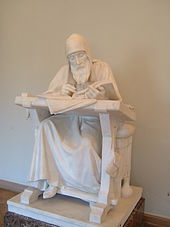Nestor of Kiev

Nestor (* 1050 in Kiev ; † October 27, 1113 ibid) was an East Slav monk and author of the first East Slavic chronicle . Nestor became a monk in the Kiev Pechersk Lavra in his youth . There he was given the task of keeping the monastery chronicle. In the 1080s he wrote the "Report on the life and fall of the blessed sufferers Boris and Gleb " and a biography of the monk Theodosius of Kiev .

In 1096 Nestor witnessed the devastation of the cave monastery.
His major work was 1112-1113, the "story of recent years" ( altostslawisch Повѣсть временныхъ лѣтъ) in German-speaking countries better known as the Primary Chronicle . In the first sentence he explains the aim of the work: "Here is the story of the past few years, how the Russian country came into being, who was first prince in Kiev and how the Russian country is organized."
Nestor uses an impressive range of sources : Russian written and oral traditions, monastic chronicles, historical collections, the Byzantine chronicles of John Malalas and George Amartolos , the reports of the boyar leader Ian Wyschatich, reports from traders, soldiers and craftsmen.
His chronicle begins with the first mention of Russia in the time of Patriarch Photius I in 856, he mentions the development of the Slavic alphabet ( Glagolica ) by Cyril of Salonica and Methodius of Saloniki and the baptism of St. Olga in Constantinople . He tells of the first Orthodox Church in Kiev (945) and of the first Russian metropolitans . He mentions the first Samoyed , reported that the Rus Norman So Vikings were that the people of Novgorod were invited to come to them and govern their city.
For Nestor, the history of Russia is part of world history from a Christian perspective - the story of the salvation of mankind.
After Nestor's death, the chronicle was continued by monks of his monastery. Often the date of death is given as 1114, because the Byzantine calendar valid at that time in Kiev allowed the following year to begin on September 1st ( old style ), i.e.: October 1113 → 1114. This is incorrect and an over- correction.
expenditure
- The Nestor Chronicle. The Old Russian Chronicle, ascribed to the monk of the Kiev-Pechersk Lavra, in the editorship of Abbot Sil'vestr from 1116, reconstructed from the manuscripts Lavrent'evskaja, Radzivilovskaja, Akademičeskaja, Troickaja, Ipat'evskaja and Chlebnikovskaja, translated by Ludolf Müller, (Forum Slavicum, Vol. 56), Munich 2001, ISBN 3-7705-3428-X .
- The Nestor Chronicle. The Old Russian text of the Nestor Chronicle in the editorship of Abbot Sil'vestr from the year 1116 and its continuation up to 1305 in the manuscript of the monk Lavrentij from 1377 as well as the continuation of the Suzdal Chronicle up to 1419 according to the Academy manuscript (Forum Slavicum, Vol. 48), Munich 1977, ISBN 3-7705-1476-9 .
- The Russian primary chronicle. Laurentian text, ed. by Samuel Hazzard Cross, Cambridge 1953.
literature
- Ludolf Müller (Hrsg.): Manual for the Nestor Chronicle. 4 volumes, Fink, Munich 1977–2001.
- Ludolf Müller: Heroes and saints from early Russian times. Thirty stories from the Old Russian Nestor Chronicle, (Sources and Studies on Russian Intellectual History, Vol. 3), Munich 1984, ISBN 3-87904-101-6 .
- Ludolf Müller: Nestor Chronicle. In: Johannes Hoops : Reallexikon der Germanischen Altertumskunde . Volume 21: Naualia - Østfold. Published by Heinrich Beck . 2nd completely revised and greatly expanded edition. Walter de Gruyter, Berlin et al. 2002, ISBN 3-11-017272-0 , pp. 94-100.
- Gottfried Schramm: Nestor Chronicle. In: Johannes Hoops : Reallexikon der Germanischen Altertumskunde . Volume 21: Naualia - Østfold. Published by Heinrich Beck . 2nd completely revised and greatly expanded edition. Walter de Gruyter, Berlin 2002, ISBN 3-11-017272-0 , pp. 100-103.
- Serge A. Zenkovsky : Medieval Russia's Epics, Chronicles, and Tales. Revised and enlarged Edition. Meridian, New York 1974, ISBN 0-452-01086-1 .
Web links
| personal data | |
|---|---|
| SURNAME | Nestor of Kiev |
| ALTERNATIVE NAMES | Nestor Kiovensis; Nestor the Annalist |
| BRIEF DESCRIPTION | East Slav monk and author of the first East Slav chronicle |
| DATE OF BIRTH | 1050 |
| PLACE OF BIRTH | Kiev |
| DATE OF DEATH | October 27, 1113 |
| Place of death | Kiev |